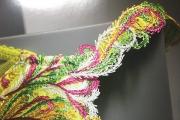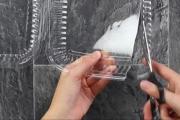How to determine men's clothing size? Applied Geodesy. We measure the height with a pencil, mirror or balloon How the height is measured
- Measurements for building a pattern for a dress, skirt or trousers must be taken off by linen. Put on for fitting the underwear with which you are going to wear the product. This is important because different shape, for example, can change the height and girth of the chest.
- All measurements are taken on the most developed part of the body. For right-handers, measurements are taken on the right side, for left-handers - on the left.
- When taking measurements, you need to stand straight, without tension, in a position familiar to the body. It is quite difficult to take measurements of oneself qualitatively. When the position of the body changes, its dimensions also change. A possible way out of the situation: take a product that fits very well on you, and take measurements from it.
- Mark the natural waistline with a rubber band or thin cord - this will simplify the task.
- Since the human body is symmetrical, usually the pattern is built only up to the middle of the figure. For convenience, some measurements are recorded at half size. These measurements include the semi-girth of the neck, chest, waist and hips, back width, width and center of the chest. The rest of the dimensions are recorded and used in full.
- V different countries pattern building systems and measuring methods are slightly different. And depending on the school, the names of the measures may differ within the same country. If you are not sure what size we are talking about, read the description. This way you can quickly find a match.
Basic figure measurements
Measurements for the shoulder product
These measurements are needed if you want to sew a dress, blouse, jacket, coat.
Measurements 1-10 are recorded and used at half size, the rest in full.
- Semi-girth of the neck- measured at the base of the neck. The tape must be closed in the jugular cavity.
- Semi-girth of the chest first- the tape runs horizontally behind the protruding points of the shoulder blades, in front - above the chest.
- Semi-girth of the second- behind the measuring tape goes as in the previous version, in front it runs along the most prominent points of the chest. It is better to remove the first and second half-grips of the chest one after another, without changing the position of the tape on the back. Maintain a natural posture with your arms down, but do not pinch the tape in the armpits.
- Half-girth of the chest third- the tape runs around the body strictly horizontally, in front - along the most prominent points of the chest, in the back - keeping horizontal. This measurement is the mass production size that is right for you.
- Half waist- measured by an auxiliary tape or elastic band located in the narrowest part of the figure. Do not try to create the waist yourself by pulling on the cord. You are beautiful no matter your size, and the correct number will help the product fit well.
- Half hip- the tape runs horizontally around the figure, behind - along the most prominent points of the buttocks, in front - taking into account the protrusion of the abdomen.
- First chest width- measured horizontally between the front angles of the armpits, above the chest.
- Second chest width- a measuring tape is applied horizontally between the anterior corners of the armpits through the most prominent points of the chest glands.
- Center of the chest- measured between the most prominent points of the chest. This size, like the half-bust, varies depending on the shape and density of the bra you are wearing.
- Back width- measured along the shoulder blades between the posterior angles of the armpits.
- Front waist length- Measured from the highest point of the estimated shoulder seam at the base of the neck to the front of the waistline. The ribbon is placed vertically along the shape. To find the highest point of the shoulder seam, wear a thin jersey shirt. Where the shoulder seam rests against the neckline, the desired point is located. You can find it before starting the measurements, mark it with a chalk, and remove the shirt.
- Chest height- the distance from the highest point of the shoulder seam to the most prominent point of the chest.
- Back waist length first- measured from the seventh cervical vertebra to the waist line. If you feel the base of the neck in the back, you will find a prominent vertebra. And you need it.
- Back waist length second- measured from the highest point of the estimated shoulder seam at the base of the neck to the back of the waistline. The ribbon is positioned vertically, following the curves of the figure.
- Back armhole height- the distance from the highest point of the shoulder seam to an imaginary horizontal line drawn from the posterior corner of the armpit.
- Shoulder height oblique- measured from the end point of the shoulder to the point of intersection of the spine with the waist line. The end point of the shoulder can be found with a thin jersey shirt with sleeves. The place where the shoulder seam enters the sleeve stitching seam is the point we need. Since you've marked your waist with elastic or tape, it should be easy to find the intersection of your waistline with your spine.
- Shoulder width- the distance from the highest point of the shoulder seam at the base of the neck to the final shoulder point.
- The length of the sleeve- measured from the end of the shoulder point to the desired length. The arm should be in a natural position, slightly bent at the elbow.
- Shoulder girth- the tape runs strictly horizontally at the widest point of the shoulder.
- Wrist girth- measured over the hand over the protruding bones.
- Length of the product- measured from the seventh cervical vertebra to the desired length.
Skirt measurements
The number of measurements required for a skirt depends on its silhouette. For a sun skirt, only the length of the product and the half-girth of the waist are needed. To sew a pencil skirt, you also need to measure the half-girth of the hips. The length of the skirt is measured from the waistline to side seam to the desired level.
Trouser Measurements
In addition to the half-girths of the waist and hips, a few more measurements are required to build trousers.
- Seat height- measured on a seated figure from the waist line along the side seam to the chair. For accurate measurements, the seating surface must be firm.
- Knee height- measured while standing from the waist line along the side seam to the middle of the kneecap.
- Knee width- especially important for tight trousers. The tape is placed around the bent knee.
- Pants width at the bottom- is selected according to the model. If you are going to sew tight trousers, then the width of the trousers at the bottom will be equal to the circumference of the foot through the heel.
- Length trousers- measured while standing from the waist line along the side seam to the desired length. In tight trousers, the length is taken to the bone. In medium or wide - to the middle of the heel, with which you will wear these trousers.
When creating a pattern, you need to remember that the measurements taken from the figure are not equal to the dimensions of the parts. When building drawings, an increase in the freedom of fitting is added to the measurements. This is not a constant value. It depends on the size of the figure, the properties of the fabric, the purpose and silhouette of the product, as well as the fashion.
And with a wardrobe, but unlike the beautiful half of humanity, they do not like to devote a lot of time to shopping for clothes, and even more so to spend lengthy fittings in stores. Some men buy clothes "by eye", while others trust the taste of their soul mate, who can go shopping for hours, choosing clothes for themselves or their loved ones. For many women, shopping is an opportunity to relieve stress and escape from problems.
Therefore, every woman with great pleasure buys clothes for her man. But in order to avoid incidental situations, and buy suitable clothes, you need to know men's sizes, then there will definitely not be any problems with the purchase.
In order to correctly take measurements from a man, you will need a measuring tape. During the measurement, the man should be wearing light clothing, the muscles of the body are relaxed. For purchase men's clothing you need the following sizes:
- ... The measuring tape should be loose around the neck. The indent should be 2 fingers.
- ... The measuring tape should run over the prominent points of the chest.

- Waist circumference... Measured at the narrowest point of the body.

- It is measured from the forearm to the wrist, with the arm slightly bent at the elbow joint.

- Side seam length... Measured along the hips, from waist to toe.

When taking measurements, the tape should not be tightly applied to the body, you should always leave 2 centimeters in reserve. The measurement results must be recorded. Knowing the men's sizes, you can easily buy any clothes, but first you should look at the size tables, where what parameters are provided that meet your man.
Men's T-shirt and Sweater Size Chart
When shopping for men's T-shirts or sweaters, you need to rely on the size of the neck, chest and sleeve length.

In this case, you need to have the dimensions of the neck girth, sleeve length, chest girth. If on long sleeve, then before buying it, you should measure the girth of the wrist.

Men's pants size chart
The main parameters when buying trousers are measured in the girth of the belt, the length of the legs along the inner and side seams.

Men's jeans size chart
Buying men's jeans you need to have measurements of the girth of the hips, the length of the legs along the side seam.

Tables of European sizes of men's clothing
European manufacturers have their own designations for men's clothing sizes, which are sometimes difficult to understand, but after studying the table, it will be much easier to navigate the sizes of foreign manufacturers.


We buy clothes by body type
Having the parameters of a man on hand, you can easily buy one or another piece of clothing. However, few people know that when choosing clothes, you need to take into account the type of figure.
- N - male clothing size, intended for men with a height of no more than 162 cm and a standard figure. Men with such a figure are more likely to wear clothes from 38 to 82 sizes.
- B - size, intended for men with a tummy, height above 162 centimeters. In this case, clothes are bought from size 51.
- S - size, suitable for men over 179 cm tall and slim figure. Clothing size from 88 sizes. In cases where a man is tall, has a large physique, then it is worth paying attention to sizes over 194.
- U - clothing size, for men with a height of less than 162 cm and a standard figure. Sizes from 24 to 32 are suitable for this category.
It should be noted that the indicators in the clothing tables may deviate slightly from the norm. This is due to both the structure of the male body and the indicators that the manufacturer adheres to. However, having men's clothing sizes on hand, you can always buy suitable clothing in which your man will be comfortable and comfortable.
It so happens that in the backyard or in the forest nearby there is a tree that is quite suitable for harvesting, or you are simply interested in its height. And in this case, many will ask the question: how to determine the height of the tree, but at the same time not to perform any manipulations with the tree, and, in particular, not to climb on it. In fact, there are several methods that are equally well suited for measuring the height of a tree, while still being reasonably accurate.
The first way is to compare the size of the shadows and calculate the proportion. To do this, you need to stand next to the tree in sunny weather in order to see the tree's shadow and your own shadow, and thus measure the size of the shadows. Knowing your height, you can easily calculate the height of the tree.
For example, your height is 170 centimeters. Your shadow will be approximately 120 centimeters. The shadow of a tree, for example, will be 320 centimeters. So, you need to decide the following proportion: divide the length of your shadow by your height and equate it to the ratio of dividing the tree's shadow by an unknown value. Thus, you get: 120: 170 = 320: x. In this case, x = 170 * 320: 120 = 453 centimeters. This will be an approximate value, but it is enough for us.
The second method for obtaining the height of a tree can be to measure it by its relative size. So, if your friend or relative stands next to a tree, and you take a pencil and move back a certain distance, then look at the pencil at outstretched arm... In this case, the pencil should appear the same size as the tree. Then place the pencil against your friend's background. Then use a pencil to measure your friend's height from a distance. Thus, if a pencil is 22 centimeters long and a tree of the same size at a distance, then your friend's height, for example, will be seven centimeters, and his real height is 168 centimeters. In this case, we also get the proportion: 7: 168 = 22: x. Having solved it, we find that the height of the tree is 528 centimeters, which is a little more than five meters.
In addition to these two methods, there are other ways to measure height. Some methods, for example, require knowledge of trigonometry and the use of an angle meter. For example, if you put a friend at a certain distance from a tree, and look from the side, you can mentally draw lines from the ground to the top of the tree through the friend's head. By measuring the resulting angle, you can calculate the height of the tree.
As you can see, calculating the height of the tree does not take much time and does not require complex or dangerous manipulations. To do this, you just need to know how to solve the proportion, as well as how to measure the relative values. And the methods used can be used not only to measure the height of trees, but also any other tall objects, for example, buildings, mountains, pillars, and so on.
Table of Russian sizes of men's clothing according to GOST.
| Russian sizes according to GOST | |||
| Size on clothes | Bust (cm) | Waist circumference (cm) | Neck circumference (cm) |
| 44 | 88 | 76 | 38 |
| 46 | 92 | 80 | 39 |
| 48 |
96 | 84 | 40 |
| 50 | 100 | 88 | 41 |
| 52 | 104 | 92 | 42 |
| 54 | 108 | 96 | 43 |
| 56 | 112 | 100 | 44 |
| 58 | 116 | 104 | 45 |
| 60 | 120 | 108 | 46 |
How to choose the size of army shoes
So that we can give correct advice when choosing a size, we need to know the following information:
- Foot length. This is the most important information for choosing a size. Below we will tell you how to correctly measure the length of the foot.
- The sizes of the shoes of the same type that you are wearing. These should be ankle boots or boots. You cannot use the size of sneakers or shoes, or sneakers.
- On shoes, as a rule, several sizes are indicated at once, depending on the scale. There are British sizes, European sizes, etc. For example: EUR-45 / US-12 / UK-11. In fact, they are the same size, but on different scales. British (UK) 10 is NOT the same as US 10. And the European (EUR) 43rd differs from the Russian 43rd by one size cm. German army ankle boots are measured in mm, and they correspond to the length of the foot, and the length of the insole will be 10mm more than the length of the foot.
- Insole length is very important information, but remember that insole length and foot length are different things. The insole is always longer than the foot.
Provide this information and the chance to make a mistake with the choice will be reduced to zero.
How to measure your foot length.
There is one correct way and many not very correct ones.
- You can just put your foot on the ruler, the error will be 1-1.5 sizes. This is the wrong way.
- You can put your foot on a piece of paper, circle the foot with a pen, and measure the length. This method is already better, but the error is 0.5-1 size. Because it's hard to circle the heel on your own while holding the handle vertically. It is still impossible to take into account how the transfer of weight affects the measured foot. It is good if someone helps you to circle the foot, but the error in the half size will remain.
- The correct way is when you stand with your back to a wall / cabinet, etc. Place your heel firmly against the wall and place a mark where the foot ends. Tight - does not mean that you have to press the foot strongly against the wall, just put it close and everything so that it is as comfortable as you expect from a shoe. The distance from the wall to the mark will be the foot length. It should be borne in mind that the floor / wall angle should be 90 degrees and there should be no baseboards. Thus, the heel is also tightly pressed, as in the boot. This removes an error of 5mm. And remember that the toes are not stretched out in shoes, they are always slightly bent. Bend your fingers a little (without fanaticism), this will remove the error by another 2-3 mm.
- It is necessary to measure the width of the foot if the shoe manufacturer divides his sizes not only by length, but also by width. Almost all original military shoes have a difference in foot width. Measuring the width is simple, it's just the width of the foot at its widest point.

How to measure your sizes for choosing clothes?
Height for determining the size of clothing is measured as follows: without shoes, you must lean your back against a vertical surface. Height is measured from crown to feet. If you are 50 years old, and once upon a time in the army they told you that your height is 185, then do not think that you have preserved all 185 centimeters, you have definitely become a little lower (usually losses are 1-2 cm in 10 years). With age, the spine "sags" and growth decreases.
Chest circumference: measured at the most prominent points of the chest. Don't take a deep breath.
Underbust Girth (Women): Measured under the bust, passing the tape under the arms at the largest part of it.
Waist circumference: measured around the waist, do not strain when measuring, hold the measuring tape closer to your body, tight like a belt. With regard to military and tactical trousers, this value is comparable with the "girth of the belt", since all trousers have a high waist (some modern trousers / jeans have a low waist / belt, this does not apply to military ones). Therefore, we say "waist circumference" - we mean "waist circumference". To make it even clearer, measure where your belt usually goes. And it should pass just below the navel.
Hip girth: measured at the most prominent points of the hips and buttocks, while putting your feet together, measure the hips in most of them, about 15-20 cm below the waist.
Pants side length: it is best to take this measurement from trousers that fit you very well. Measure without taking into account the waistband to the bottom of the pants. Otherwise it can be measured on the body, starting from the bone of the thigh to the feet.
Inseam: measure the length from crotch to bottom along the seam, it is best to take this measurement from trousers that fit you very well.
The length of the sleeve: Measure the sleeve length from the center of your neck at the back, around your elbow slightly bent towards your wrist.
Glove size: the circumference of the fullest part of the arm, just in front of the joints, excluding the thumb.
When measuring, the dimensions should be rounded up, a loose thing looks more beautiful than a slightly small one. But it is even better not to round anything, but to tell the manager the exact data, since some things are larger, and some are small.
What you need to tell us so that we can help you choose the size:
1) Chest circumference.
2) Waist circumference.
3) Girth in the belt (the place where you have the belt in your trousers).
4) What sizes do you usually wear (T-shirts, jackets, trousers, jeans, sweaters, etc., the more the better), indicating which item the size belongs to. For example: " T-shirt XL, jacket L, trousers Bundeswehr Gr9".
When you are seriously passionate about something, then you probably do it with all your heart, not forgetting to keep track of your results. After all, this applies equally to sports. If you are determined to achieve any results, you follow the progress of each workout and the changes that occur to your body. This article will come to your aid on how to correctly take body measurements.
But there are many ways to determine the results of training, so, in order not to bother you, I will tell you about the most basic of them. To begin with, we will determine the effectiveness of training for the purpose of losing weight and gaining muscle mass, there are three of them: weighing, body measurements and measuring subcutaneous fat. These three methods complement each other and in total give a complete picture of what is happening.
The simplest and most regular thing that all people involved in sports do is are weighed... It is necessary to monitor your weight, but you cannot rely on this indicator alone. Since when losing weight, a situation may arise that, on the contrary, you will gain a little weight, but this weight will not be gained due to fat, but due to an increase in muscle mass. However, as is correct, this is a very small probability, since when you dry out (lose weight), your calorie content decreases, and for muscle growth, on the contrary, you need to increase the calorie content (its excess). Although this also happens - the weight grows (weight and volume of the body), but not due to the increase in muscle tissue, but due to the appearance of excess subcutaneous fat or vice versa ...
Basic rules for weighing:
- It is necessary to weigh yourself every week, at the same time and on the same day of the week.
- You need to weigh yourself after using the toilet and before breakfast.
But in order for the picture to be more complete, in addition to weighing, you should take measurements of body volumes and measurements of fat folds with the help of a caliper, because only then you will track your achievements and body changes in dynamics (as correctly as possible). You will learn more about measurements of subcutaneous fat in the article:.
The second way is body measurements
It is more accurate than the first, but as already mentioned, they must be combined.
Body measurements (body measurements) can be made with an ordinary measuring tape, or with paper or thread, after which you can take readings with a ruler. The first method is more convenient, but if there is no measuring tape at hand, then the second method is also perfect. So, how to measure correctly and what places? All this in order.

Body measurements for weight loss and weight gain
Wrist- measurement occurs with a relaxed hand, in the thinnest place (above the protruding bone).

Forearm(part of the arm from the elbow to the wrist). It is measured in two states - relaxed and tense. In the first - the arm hangs calmly along the body, in the second - the arm is bent at an angle of 90 degrees, the muscles are tense. In both cases, the thickest part is measured.
Shoulder(this is part of the arm from elbow to shoulder, not shoulder to neck). Measured in a calm state - the arm hangs along the body, relaxed. Measurement in a tense state - the hand is raised and clenched into a fist at head level.
Neck... Measured in a calm state - the chin is slightly raised, the measuring tape lies horizontally, and not obliquely. Do not try to pull your neck into the body or pull, or even press your chin to your chest - this will not improve the results of your workouts, but on the contrary deceive yourself.
Rib cage - measured at the widest point - in men and at the most prominent points - in women. In a calm state - the measurement is done after a calm, normal inhalation (do not inhale too deeply, protrude your chest). In a tense state - it is necessary to tighten the muscles of the back and chest and slightly spread the elbows to the sides. There is another option for measuring the chest. Measure it at maximum inhalation, then also at maximum exhalation. Add up the readings, then divide by two, the resulting number is the average volume of your chest.

Waist - measured at the thinnest point, if you have one. And if there is a protruding belly, then the measurement is made, on the contrary, along the widest part. Do not try, again, to deceive the readings, so do not pull in your stomach, and do not pull the measuring tape too tight, but it should not sag either - just fit it to the measurement site. If you want to measure the waist in a tense state, then tighten the abdominal muscles and measure.
Buttocks - are measured, as a rule, in a relaxed state, at the most protruding points. That is why at the very beginning of the article it was said that it is better to take measurements with an assistant; it can be difficult not only to find the most prominent points behind, but also to measure correctly.
Hip- the widest part is measured, in a relaxed state, either standing calmly, or with a bent leg on a chair. In a tense state - standing, the leg is straightened, the muscles are tense.
Shin- measured at the widest point. Relaxed state - the leg is placed on a chair, tense state - rising on the toe, transfer the body weight to the leg you are measuring.
Ankle(be between the foot and lower leg) - you need to measure while standing on straight legs, in the thinnest part.
Rules and features in body measurements:
- You need to take measurements in the same places, at the same time of day and several times at the same place (for greater accuracy), but the same the best time- morning, after the toilet and before breakfast. Since the human body tends to swell at the end of the day, besides, weight can fluctuate significantly depending on the amount of food eaten per day.
- It makes no sense to take body measurements more often than once every two weeks for those who work on mass (muscle growth), since muscle growth is a very long and painstaking process. But who is losing weight - measurements once a week are quite enough ...
- It is better if someone will help you take body measurements, because it is inconvenient to carry out such manipulations alone. But, and if they are not carried out correctly, then the results of the training may not be as encouraging as we would like ...
- It is not gentle to take measurements immediately after training. Since during training, the vessels and capillaries (reserve) of our body expand, and therefore more blood begins to circulate through the muscles, as a result, the muscles become larger. Yes, you yourself have noticed how the muscles "inflate" after training ...
- By the way, the volumes of the right and left parts of the body differ due to the physiological and anatomical characteristics of each person. You will learn more about this in the article:.
- Always write down, or remember exactly where and on which side (right or left side of the body) the measurements were taken, in order to do them exactly in the same place next time.
- Note in what state the body measurement was taken - relaxed or calm.
The third way is to measure subcutaneous fat.
In addition to all the above measurements, it is necessary to periodically and regularly measure the fat layer (subcutaneous). Because the volume can grow due to subcutaneous fat, and you will think that it is your muscles that are growing.
There is a huge variety of methods for determining subcutaneous fat. Therefore, to find out in detail about each of them and choose the most suitable one for yourself, read the article: How to measure subcutaneous fat. Although I, better advise the way - Calipometry, as it is one of the precise and simple ones.
Also, a record of measurements that was missed due to lack of time or banal laziness can greatly ruin the picture of intensified training. Do you remember exactly all the numbers obtained, say, a couple of weeks ago? It is unlikely ... But without this, it will not be clear how far you have progressed in losing weight or building muscle.
Other Ways to Measure Training Performance
- For those involved in strength training, the results can also be recorded based on the number of approaches, repetitions and weights lifted. But all this data must be recorded in a training diary, otherwise you will not be able to control your progress.
- For those who develop endurance, it will be useful to record the time of overcoming the distances, the number of contractions of the heart muscle and the distance covered. All this data also needs to be recorded in your training diary in order to visually see your achievements.
- And the last way for today is photo diary, in principle, it is a good alternative to body measurements. Every month you take three (main) photos of your body, without clothes - front, back and side. But you need to take pictures constantly from the same distance and angle, otherwise the training results will not be accurate. As a result, comparing the photographs, for several months, you can see the difference not only in numbers, but also externally in the photographs. In this method, you can choose which part of the body to photograph, it does not interfere in any way, but on the contrary ...
- Do not be very scared and worried if the weight suddenly "stands up" or the muscles stop growing. In both cases, you need to revise your training program and diet. You will learn more about nutrition for weight loss and muscle growth.
- There can also be many reasons and why muscle mass stops growing. Some of the main ones: lack of nutrients (energy), lack of recovery, there is no progression of the load, poor exercise technique and your energy system is not yet ready for further growth, so it needs to be further developed (train regularly and follow the training program). If you analyze it, you will find what your problem is stagnation (plateau).
- It is quite possible that the weight that was running away so quickly again decided to settle on your sides and waist, just because a series of holidays passed in your life, and the diet was slightly disturbed. Or maybe you were sick or worked very hard, so you had no time for training.
Summarize
So we examined the topic: Based on this, it becomes clear that in any sport it is necessary to analyze and verify the results, but if you do not do this, then you will simply “stand still” and not progress. For this very reason, all athletes - pay very much essential control of their achievements. After all, if you scrupulously follow any process, then in the end you will learn how to manage it (results).
Go in for sports, eat right and get better - I wish you success.














